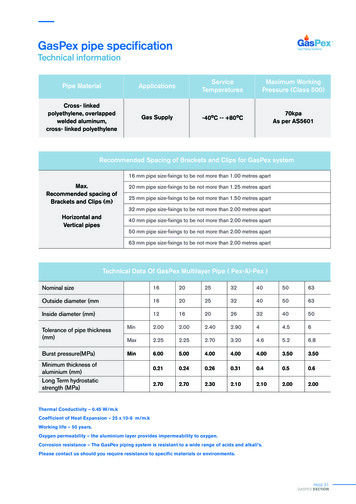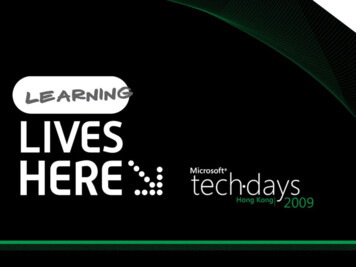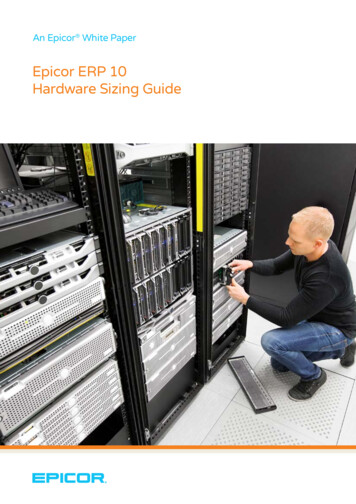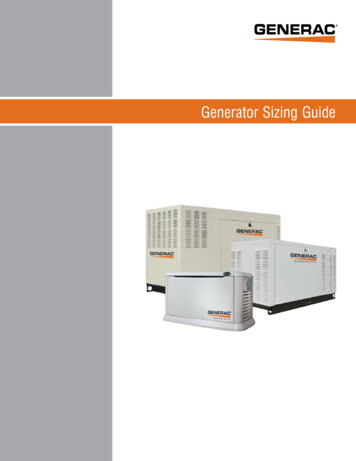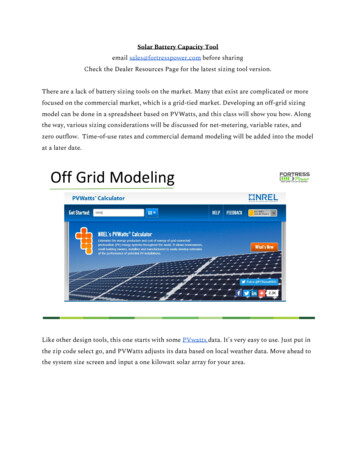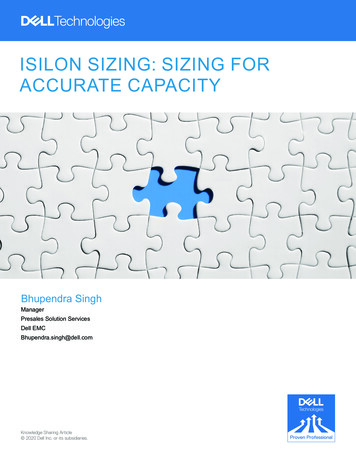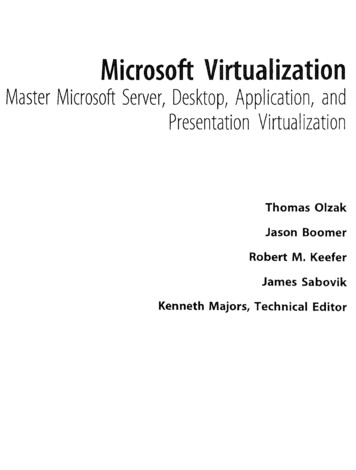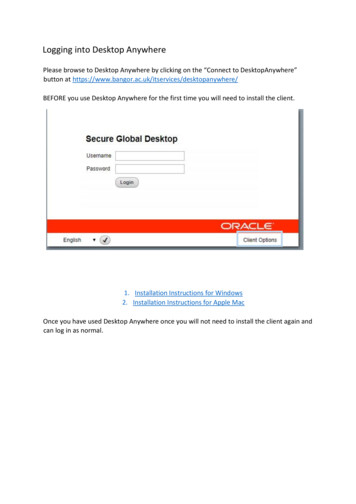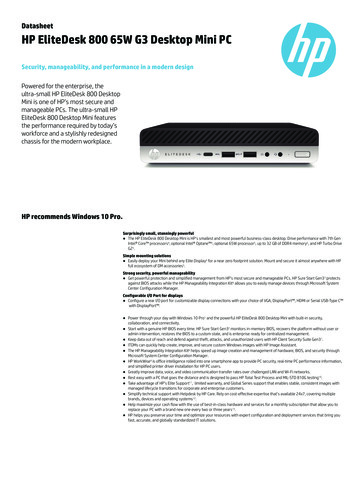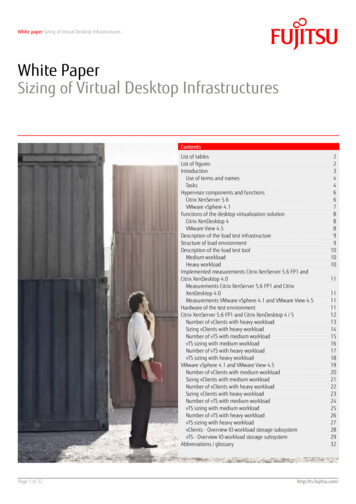
Transcription
White paper Sizing of Virtual Desktop InfrastructuresWhite PaperSizing of Virtual Desktop InfrastructuresContentsList of tablesList of figuresIntroductionUse of terms and namesTasksHypervisor components and functionsCitrix XenServer 5.6VMware vSphere 4.1Functions of the desktop virtualization solutionCitrix XenDesktop 4VMware View 4.5Description of the load test infrastructureStructure of load environmentDescription of the load test toolMedium workloadHeavy workloadImplemented measurements Citrix XenServer 5.6 FP1 andCitrix XenDesktop 4.0Measurements Citrix XenServer 5.6 FP1 and CitrixXenDesktop 4.0Measurements VMware vSphere 4.1 and VMware View 4.5Hardware of the test environmentCitrix XenServer 5.6 FP1 and Citrix XenDesktop 4 / 5Number of vClients with heavy workloadSizing vClients with heavy workloadNumber of vTS with medium workloadvTS sizing with medium workloadNumber of vTS with heavy workloadvTS sizing with heavy workloadVMware vSphere 4.1 and VMware View 4.5Number of vClients with medium workloadSizing vClients with medium workloadNumber of vClients with heavy workloadSizing vClients with heavy workloadNumber of vTS with medium workloadvTS sizing with medium workloadNumber of vTS with heavy workloadvTS sizing with heavy workloadvClients - Overview IO workload storage subsystemvTS - Overview IO workload storage subsystemAbbreviations / glossaryPage 1 of 22324252627282932http://ts.fujitsu.com/
White paper Sizing of Virtual Desktop InfrastructuresList of tablesTable 1: XenServer Editions . 6Table 2: Infrastructure Servers . 11Table 3: Sizing vClients with heavy workload . 14Table 4: vTS - Sizing with medium workload . 16Table 5: vTS - Sizing with heavy workload . 18Table 6: Sizing vClients with medium workload . 21Table 7: Sizing vClients with heavy workload . 23Table 8: vTS - Sizing with medium workload . 25Table 9: vTS - Sizing with heavy workload . 27Table 10: Summary sizing medium workload . 30Table 11: Summary sizing heavy workload . 31Table 12: Advantages/disadvantages . 31Table 13: List of abbreviations . 32List of figuresFigure 1: Dependencies of CPU, RAM and storage. 3Figure 2: Market positioning Hypervisors (according to Gartner) . 5Figure 3: Overview for Hypervisor VMware vSphere 4.1 . 7Figure 4: Structure diagram . 9Figure 5: VSI-max vClients with heavy workload . 13Figure 6: VSI-max vTS with medium workload . 15Figure 7: VSI-max vTS with heavy workload . 17Figure 8: VSI-max vClients with medium workload . 20Figure 9: VSI-max vClients with heavy workload . 22Figure 10: VSI-max vTS with medium workload . 24Figure 11: VSI-max vTS with heavy workload . 26Figure 12: vClients overview IO workload . 28Figure 13: vTS overview IO workload . 29Page 2 of 32http://ts.fujitsu.com/
White paper Sizing of Virtual Desktop InfrastructuresIntroductionThis document is designed to illustrate the requirements of a virtual desktop infrastructure (VDI). The focus is on the CPU and RAM requirementsand also in particular on the requirements of the storage subsystem. The network and bandwidth requirements are not part of this White Paper.The results can be used as a basis for sizing a corresponding VDI environment based on Citrix XenDesktop 4 / 5 or VMware View 4.5 / 4.6 / 51.In order to offer the best possible efficient VDI solution, it is important to align the three resources CPU, RAM and Disk IO as best as possible. Ifone of the components is not the correct size, an optimal use of resources is no longer possible. The Disk IO is usually the limiting factor intoday's VDI environments. The RAM is second as a possible bottleneck. The CPU resource is usually not a limiting factor in today's VDIarchitectures – but is frequently incorrectly identified as such. This is due to the manner in which the resource CPU is displayed on theadministration consoles. The CPU utilization is usually displayed here. However, there is no differentiation between the actual implementedcomputing cycles and the wait cycles (so-called "wait states"). In today's VDI scenarios the percentage of actual CPU computing work is normallyclearly under 10%. The remaining 90% of the available CPU performance is used up in "Waiting―, e.g. for hard disk read processes.The CPU utilization display in the administration tools (e.g. VMware vCenter Performance, Citrix XenCenter Performance) shows 100% CPUutilization in such situations as the CPU can no longer accept any further jobs. Wait states occur in virtual infrastructures in a massive manner asseveral virtual machines with multiple operating systems clearly create more wait states than a single physical system with only one operatingsystem. However, both physical and virtual systems struggle with the large CPU performance discrepancy (fastest resource), RAM (2nd fastestresource) and storage (slowest resource). Thus it is not surprising that unfavorably sized RAM and/or storage subsystem performance that is toolow (disk IO), are the most frequent reasons for an increased number of wait states on the CPU side. This prevents optimal utilization of existingvirtual infrastructure resources. The inquiries, seen here as raindrops, fill the wait queues of therespective resource – seen here as containers. If a resource such as disk IO is "full", the other resources that arestill "empty and free" fill up automatically; wait states arise. The CPU is thus filled up until it is "completely full". As soon as theCPU can no longer take on any more jobs, there is a jam waitingusually for "slower" resources. Once this status is reached, you canusually only indirectly determine who is originally responsible forthe situation.DISK-IORAMCPUFigure 1: Dependencies of CPU, RAM and storage1As of VMware View 5 it will probably be possible to save the Replica Disk with Linked Clones in the RAM of the vSphere 5.0 Hypervisor Server. Thisresults in clearly fewer read IOPS on the SAN side. If this option is not used, the SAN requirements will probably remain comparable for View 5 aswell.Page 3 of 32http://ts.fujitsu.com/
White paper Sizing of Virtual Desktop InfrastructuresUse of terms and namesHyperlinks as footnotes have been included in the text for more information about specific products or manufacturers. Recurring abbreviations orterms are explained in the Appendix, together with a hyperlink to the source. The abbreviations and terms when first appearing in the text arelinked to the glossary. Product and trade names are usually abbreviated: Microsoft Corporation:Windows 7:Citrix Systems, Inc.:Citrix XenApp :Citrix XenDesktop :Citrix XenServer :VMware :VMware View :VMware vCenterTM:VMware vSphereTM:VMware ThinAppTM:Oracle :Sun Microsystems:Cisco :MicrosoftWindows SphereThinAppOracleSunCiscoThe Microsoft trademarks can be seen at: marks/de-de.mspx.The Citrix trademarks as well as the regulations for the correct name and identification can be found al/secondLevel.asp?level2ID 2 210.Cisco trademarks are listed demark.html .All other products named in this document are trademarks of the respective manufacturer.Tasks Develop and set up a POC (proof-of-concept) in order to simulate the operations load on virtual clients (vClients)which arises with standard users. Compare the technologies VMware "Linked Clone" and Citrix "XenDesktop/Provisioning". Create a decision matrix and an in-depth recommendation to continue using suitable technology. Create test documentationThe following was taken into account when making the load measurements: The load simulation is to be carried out, on the one hand, using normal load simulation programs, and on the other hand the comparison withthe manufacturer's determined values should be permitted. The basic environment should be kept the same for comparison reasons and any special optimization should be avoided.Page 4 of 32http://ts.fujitsu.com/
White paper Sizing of Virtual Desktop InfrastructuresMarket observation and product selectionThe basis for the results document was the following Hypervisor and management solutions: Citrix XenServer 5.6 and XenCenter 5.6 VMware ESX vSphere 4.1 and vCenter 4.12Information made available by the market research institute Gartner (May 2010; replaced with updated figures in June 2011) acted as the basisfor product and manufacturer selection.Figure 2: Market positioning Hypervisors (according to Gartner)The above products from the manufacturers VMware, Microsoft und Citrix are the three most sophisticated and best established Bare MetalHypervisor products for x86 server virtualization. Furthermore, the operating systems to be virtualized within the measurements are based onWindows, with the focus on Windows 7 (x64) and Windows Server 2008 R2 (x64).The three Hypervisor product packages specified above from the manufacturers Citrix, Microsoft and VMware have been extended to includedesktop virtualization products. As Microsoft in larger environments ( 500 clients) also recommends the Citrix components for brokering andprovisioning, it was decided not to run parallel tests with Hyper-V 2.0 for time reasons. Individual measurements on another hardware basisshowed comparable results for the XenServer 5.6 with Hyper-V 2.0.The following combinations were used according to manufacturer recommendations:Citrix XenDesktop 4 (VDI component) and Citrix XenServer 5.6 (Hypervisor)VMware View v4.5 (VDI component) and VMware ESX vSphere 4.1 (Hypervisor)Details about the test structure are also in section „Structure of load environment―2Source: ional/citirix magic quadrant 2011.pdfPage 5 of 32http://ts.fujitsu.com/
White paper Sizing of Virtual Desktop InfrastructuresTechnology descriptionHypervisor components and functionsCitrix XenServer 5.6According to Citrix the "Citrix XenServer is the only cloud-capable server virtualization platform for companies of any size which offers all themain functions for the virtualization of all servers and data centers — scaling for different company sizes, support for Windows and Linuxoperating system and complex storage requirements, centralized management of several servers, live migration of virtual machines and muchmore. Irrespective of the XenServer Edition you choose as starting-point, the various Editions are all compatible with each other. Upgrades can bemade easily via a new license key without having to install additional software or take systems out of operation. The pricing for XenServer is mentandautomationFunctionXenServer hypervisorXenMotion live migrationVM Disk snapshot and revertXenCenter multi-server managementResilient distributed management architectureConversion toolsHigh availabilityMemory optimizationPerformance alerting and reportingAutomated workload balancingHeterogeneous poolsHost power managementProvisioning services (virtual)Role-based administrationLive memory snapshots and revertsCitrix StorageLinkLifecycle managementProvisioning services (physical)Site recoveryFreeAdvancedEnterprisePlatinumTable 1: XenServer EditionsPage 6 of 32http://ts.fujitsu.com/
White paper Sizing of Virtual Desktop InfrastructuresVMware vSphere 4.1According to manufacturer specifications „VMware vSphere comprises a range of components via which industry standard hardware can be usedlike a flexible mainframe environment with integrated service level control for all applications. The VMware vSphere components are divided intothe following categories:Infrastructure Services - This group of components virtualizes server, storage and network resources comprehensively, bundles them and assignsapplications as required and according to business priority.Application Services - This group of components offers integrated service level controls for all applications on the platform of the Cloud operatingsystem, irrespective of the type of application or operating system used.VMware vCenter Server provides a central control point for virtualization management. This is an important component to manage infrastructureand application services which offer a detailed view of all aspects involved in virtual infrastructure, the automation of daily operation proceduresand the necessary scaling to manage large data center environments.―Figure 3: Overview for Hypervisor VMware vSphere 4.1Page 7 of 32http://ts.fujitsu.com/
White paper Sizing of Virtual Desktop InfrastructuresFunctions of the desktop virtualization solutionCitrix XenDesktop 43Citrix with XenDesktop is able to retain different types of central virtualized workplaces. The Citrix provisioning concept thus offers a very largerange of possible scenarios for providing virtual desktops.Here is an overview of the XenDesktop scenarios:Hosted Shared Desktop: This desktop meets the requirements of the so-called "Task Worker". These users do not install any programs on their ownand only need a relatively small amount of computer performance. Hosted Shared Desktops are provided on terminal server farms.Hosted Virtual Desktop: This solution is designed for user groups that use special software or install new programs (e.g. developers). The Desktopis constantly as a vClient on a Hypervisor and is not dynamically created and rejected.Hosted Central Desktop: If the Hosted Central Desktop high-performance desktop is used, the user is using his own physical hardware (e.g.workstation) in the data center. This version is usually for "Power Users―, whose tasks demand particularly large amounts of CPU performance.Local Streamed Desktop: One or more Citrix Provisioning Servers (PvS) stream individual, multi-useable standard desktop images (vDisks) ontothe physical or virtual processors of the users. Booting is via the network. Provisioning Servers are used to provide - having once created a masterimage - a theoretically unlimited number of desktops with virtualized hard disks. The computer performance itself for this version is supplied bythe client device as before. Ideal for companies whose users require absolutely identically configured PC workplaces.Additional flexibility is provided by separating the operating system and the application level: XenApp - as a separate unit - provides thedesktops centralized via XenDesktop with applications. The administrator can always choose whether to have the applications fixed in theoperating system or whether to provide them virtualized or streamed via XenApp.VMware View 4.5VMware has the following solutions:Automated Pool: An automated pool contains one or more virtual desktops which are automatically created and modified via the View Manager.These machines are based on a template which is managed in the Virtual Center Server. Access management is also via the View Client.Automated desktops can be dedicated or floating desktops. Dedicated desktops: the user is automatically assigned to a specific vClient. Floatingdesktops: the user is given any one of the available desktops. This can be a different vClient with each log-in.So-called linked clones can be used with automated desktop pools. A linked clone is a special version of the normal clone. The normal full cloneis the entire copy of a virtual machine and is completely separate. A linked clone is a reference to an existing vClient - the so-called master image- and thus clearly uses less disk space in comparison to a full clone. However, this also means that the linked clone is always dependent on themaster image which must be available. The entire vClient is not changed by the operation of a linked clone; read rights for the master image aresufficient in operation. The necessary write events are in the linked clone directory. Each linked clone once created is started independently andacts like a self-sufficient vClient in operation.3Sources: top/Page 8 of 32http://ts.fujitsu.com/
White paper Sizing of Virtual Desktop InfrastructuresManual Pool: A manual desktop pool consists of a mix of virtual and physical desktops. These desktops can always be differentiated and are notbased on a standardized original image. The administration and access management is via the View Client.The manual desktop pools also have dedicated and floating desktops. You thus have a mix of individual and automated pools with a differentoriginal basis.Terminal Services Pool: These are systems based on Microsoft Terminal Services which can also be managed by View Manager. This type ofdesktop pools was not considered in the test.As far as VMware is concerned, applications can be contained either directly in the basic image of the virtual machine or the template.Alternatively, applications can also be provided via Terminal Services or via ThinApp (application virtualization).ThinApp is a very attractive solution option. However, this is rather impractical in its current status regarding the management of applicationsand the distribution. There is no management console or anything comparable via which the administrator can distribute the applications tospecific users either centrally or in an automated manner. Solutions for this problem must currently be provided manually in other ways, forexample via scripting.Description of the load test infrastructureStructure of load environmentFigure 4: Structure diagramAll infrastructure servers are hosted on cluster #1 in order to minimize any possible affect on the load tests. The vSphere 4.0 ESX host withseparate vCenter (vCenter 4.0) used in previous tests was still used.Only a server with VMware vSphere 4.1 Hypervisor for the VMware View tests is used for the load test measurements of the VMs or a server withXenServer 5.6 FP1 as Hypervisor for the XenDesktop tests. A physical provisioning server was also in operation in order to fully exploit theperformance capability of the Citrix solution.For details, see table 2 – Infrastructure server.Page 9 of 32http://ts.fujitsu.com/
White paper Sizing of Virtual Desktop InfrastructuresDescription of the load test toolIn order to achieve comparable results with the different technologies it is necessary to use an independent tool (as much as possible) to createand simulate user-similar load situations. The tool VSI Pro from the company Login Consultants was thus chosen.At the moment of the test VSI Pro was the only known tool to support all three Hypervisor technologies to be supported; Citrix XenServer, VMwareESX and Microsoft Hyper-V 2.0. Furthermore, VSI Pro offers numerous access options so that - in addition to the RDP protocol - the ICA protocolcan also be used. The load can be directly created on one or more targets.Please note that VSI Pro merely initiates the connection set-up via different protocols and initiates the load test. The actual operation load is thencreated locally on the test target system.Additional optimization with the protocols (PCoIP, ICA, RDP) are thus not taken into account within the VSI Pro tests. Further advantages can beobtained with a terminal in practical operations, for example by moving CPU calculations from the Hypervisor to the terminal (e.g. Thin Client).There are a lot of free publications about the tool VSI-Pro. In particular, http://projectvrc.nl is a good source of information.VSI Pro supports many load profiles which can create various high operation loads. The two VSI-Pro load profiles "Medium" and "Heavy" were usedto create this White Paper.Measurements with up to 1,000 physical Windows XP based rich clients showed a general degree of load which corresponds to the "Medium" loadprofile, while taking the extra load into consideration caused by the planned operating system change from Windows XP (32-bit) to Windows 7(64-bit).The following section describes the different load profiles of VSI Pro4 in its original version.Medium workloadThe medium workload is the default workload in VSI. This workload emulated a medium knowledge worker using Office, IE and PDF. Once a session has been started, the medium workload will repeat every 12 minutes. During each loop, the response time is measured every 2 minutes. The medium workload opens up to 5 applications simultaneously. The type rate is 160 ms per character. The medium workload in VSI 2.0 is approximately 35% more resource-intensive than in VSI 1.0. Approximately 2 minutes of idle time is included to simulate real-world users.Each loop will open and use: Outlook 2007, browse 10 messages. Internet Explorer, one instance is left open (BBC.co.uk), one instance is browsed to Wired.com, Lonelyplanet.com and heavy flash appgettheglass.com (not used with MediumNoFlash workload). Word 2007, one instance to measure response time, one instance to review and edit document. Bullzip PDF Printer & Acrobat Reader, the word document is printed and reviewed to PDF. Excel 2007, a very large randomized sheet is opened. PowerPoint 2007, a presentation is reviewed and edited. 7-zip: using the command line version the output of the session is zipped.Heavy workloadThis workload simulates a power user. It is based on the medium workload.Difference in comparison to the medium workload: Type rate is 130 ms per character. Idle time total is only 40 seconds. The heavy workload opens up to 8 applications simultaneously.4Source: VSI Pro Admin GuidePage 10 of 32http://ts.fujitsu.com/
White paper Sizing of Virtual Desktop InfrastructuresImplemented measurements Citrix XenServer 5.6 FP1 and Citrix XenDesktop 4.0Measurements Citrix XenServer 5.6 FP1 and Citrix XenDesktop 4.05 Number of vClients with load profile "Medium" Number of vClients with load profile "Heavy" Number of virtual terminal servers (vTS) with medium load profil Number of vTS load profile "Heavy"Measurements VMware vSphere 4.1 and VMware View 4.5 Number of vClients with load profile "Medium" Number of vClients with load profile "Heavy" Number of vTS with load profile "Medium" Number of vTS load profile "Heavy"Hardware of the test environmentIn addition to the integrated network and SAN infrastructure components, the following hardware was used for the load test: 2 Blade servers with the following configuration 2x Intel Xeon X5670 2.93GHz 12x8GB RAM 2 Blade servers with the following configuration 2x Intel Xeon X5650 2.66GHz 24x8GB RAM SAN storage subsystem Type: EMC CX4-480 FastCache 185 GB Powerpath (4 paths, 2 of which are active in the round robin) 3x RAID 5 (9x 300GB FC HDDs, 3 LUNs each with 2.4 TB capacity) 1x RAID 5 (5x 300GB FC HDDs, 1 LUN each with 1.2 TB capacity) 1x RAID 5 (5x 100GB SATAII EFD HDDs, 1 LUN with 400 GB capacity)Name and functionIP addressOperating systemDC1: Domain Controller130.250.224.1Windows Server 2008 EE R2 x64VC2: VMware vCenter 4.0130.250.224.2Windows Server 2008 EE R2 x64SQL: Database Server MS SQL 2008 EE130.250.224.3Windows Server 2008 EE R2 x64DDC1: Desktop Delivery Controller (DDC)130.250.224.7Windows Server 2003 EE 32bitDDC2: Desktop Delivery Controller (DDC)130.250.224.8Windows Server 2003 EE 32bitPVS1: Provisioning Server PvS 5.6130.250.224.9Windows Server 2008 EE R2 x64PVS2: Provisioning Server PvS 5.6130.250.224.10Windows Server 2008 EE R2 x64PVS3: Physical Provisioning Server PvS 5.6130.250.224.33Windows Server 2008 EE R2 x64LIC1 : Citrix License Server Lic 11.9130.250.224.11Windows Server 2003 EE 32bitVC3: VMware vCenter 4.1, View 4.5130.250.224.20Windows Server 2008 EE R2 x64CS3: VMware Connection Server CS 4.5130.250.224.21Windows Server 2008 EE R2 x64VSI-XA6-000: XenApp6-Server Master and Web Interface130.250.224.30Windows Server 2008 EE R2 x64Table 2: Infrastructure Servers5The medium workload of Citrix vClients could - for time reasons - only be determined in another load environment with older hardware,but not in the load test environment described here.Page 11 of 32http://ts.fujitsu.com/
White paper Sizing of Virtual Desktop InfrastructuresTest results from the workload test environmentAll measurement results shown are consolidated in an Excel table. See also Error! Reference source not found.Citrix XenServer 5.6 FP1 and Citrix XenDesktop 4 / 5As the VSI Pro load tests only use the virtual covers on the XenServer and the provisioning server is also unchanged with XenDesktop 5, theresults can also be used on XenDesktop 5 in combination with PvS 5.6. The measurements of the vClients in the medium load profile could nolonger be carried out due to the test time limits. However, previous measurements in another load test environment permit relatively exactcalculations and estimates.Configuration vClient OS:Windows 7 (x64) CPU:1 vCPU6 RAM:1536 MB7 HDD:30 GB vDisk (Thick ) 3 GB vDisk with 2 GB PagefileConfiguration vTS OS:Windows 2008 R2 (x64) with extension Citrix XenApp6 CPU:4 vCPU8 RAM:24576 MB, of which 8196 MB is as ―Write Cache in RAM‖ HDD:8 GB vDisk with 4 GB Pagefile, 30 GB vDisk (Thick) as OS partition on provisioning server Number: 66Citrix sets the RAM minimum size recommended by Microsoft for all templates to 2 GB for Windows 7 (x64). This lower limit must thus bechanged in order to use less RAM and the Dynamic Memory Control Feature. This occurs via the following commands within the XenServer console:1)xe vm-lista)Note uuid of the VM to be modified2)xe vm-memory-static-range-set uuid db5d28e6-039a-d10e-e38e-9550c1c32678 min 1024MiB max 2048MiB3)xe vm-memory-dynamic-range-set uuid db5d28e6-039a-d10e-e38e-9550c1c32678 min 1024MiB max 2048MiB7There are always two modes when assigning storage capacity:Thick the entire allocated capacity is already initially reserved on storage for the VM, irrespective of how much actual data is in the VM partition;optimal performanceFast or Thin the assigned capacity is always available for the VM, but on storage only the capacity is used which is filled with data; optimalcapaci
Description of the load test infrastructure 9 Structure of load environment 9 Description of the load test tool 10 Medium workload 10 Heavy workload 10 Implemented measurements Citrix XenServer 5.6 FP1 and Citrix XenDesktop 4.0 11 Measurements Citrix XenServer 5.6 FP1 and Citrix XenDesktop 4.0 11 Measurements VMware vSphere 4.1 and VMware View .

